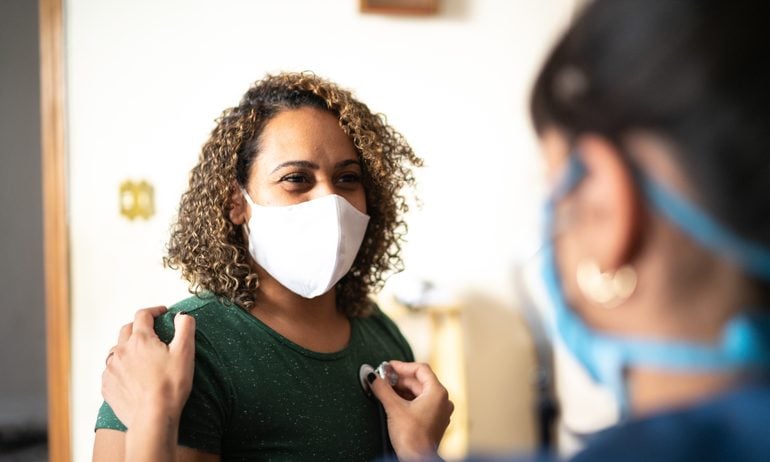Should You Choose a High-Deductible Health Plan?
Whether an HDHP is right for you will depend on your medical and financial situation.

Many, or all, of the products featured on this page are from our advertising partners who compensate us when you take certain actions on our website or click to take an action on their website. However, this does not influence our evaluations. Our opinions are our own. Here is a list of our partners and here's how we make money.
High-deductible health plans usually carry lower premiums but require more out-of-pocket spending before insurance starts paying for care. Meanwhile, health insurance plans with lower deductibles offer more predictable costs and often more generous coverage, but they usually come with higher premiums.


Get the Care You Need
What is a high-deductible health plan?
Compared to a traditional low-deductible health plan, a high-deductible health plan, or HDHP, requires you to pay a higher amount for medical care out of pocket before your insurance starts covering eligible costs. The amount you pay out of pocket is called the deductible.
According to the IRS, an HDHP is defined as the following:
Any health plan carrying a deductible of at least $1,650 for an individual or $3,300 for a family in 2025 ($1,700 and $3,400 in 2026).
Total out-of-pocket expenses for the year can’t exceed $8,300 for an individual or $16,600 for a family in 2025 ($8,500 and $17,000 in 2026), including deductibles, copayments and coinsurance.
HDHPs may cover some preventive care benefits at no or minimal cost. This could include the following:
Annual physicals.
Immunizations.
Routine prenatal care and well-child visits.
Screening services for things like cancer, heart disease, pediatric conditions, and vision and hearing disorders.
Tobacco cessation programs.
Obesity weight-loss programs.
HDHPs were intended to encourage consumers to shop around for health care. The logic is that if you’re responsible for medical costs upfront, you’ll do more work to find lower-cost providers — cutting expenses for you and your insurer.
In practice, this hasn’t panned out for most people. People with HDHPs aren’t shopping around for health care or talking with providers about costs, according to research from the University of Michigan Institute for Healthcare Policy and Innovation. And although consumers with HDHPs tend to reduce costs, they do so by skipping out on care and medication.
High-deductible health plans and HSAs
One of the perks of having an HDHP is that you may be eligible to save funds in a health savings account, or HSA. They are tax-advantaged, meaning you can direct funds from your paycheck pretax into an HSA, or you can add the money post-tax and deduct taxes later.
In 2025, the annual HSA contribution limit for an individual is $4,300 ($4,400 in 2026). Someone with family coverage can contribute up to $8,550 ($8,750 in 2026). An employer may also contribute to your HSA.
HSA money can earn interest, can be invested in stocks or mutual funds and can be spent (tax-free) on any qualifying medical expenses, as defined by the IRS. You can contribute to one as long as you have an active qualifying HDHP and no other health coverage. HSA money also rolls over year to year, so you can use it when you need it.
Not all HDHPs qualify you for an HSA, so make sure the one you choose meets IRS requirements.
Pros and cons of a high-deductible health plan
There are several reasons you might decide for or against this kind of health plan.
Pros:
Typically lower premiums: These types of plans usually cost less per month than more traditional health plans with a lower deductible.
Ability to use an HSA: Having a qualified HDHP means you’re eligible to put thousands of pretax dollars into an HSA, which you can use for medical expenses this year or in the future. Your HSA money can also be invested and grow over time.
Employer contribution: Roughly two-thirds of employers offering HDHPs make contributions toward their workers’ HSAs, according to data from health policy nonprofit KFF. That’s essentially free money toward your health care costs.
Cons:
High costs for initial care: If you manage a chronic illness or you seek frequent health care beyond preventive visits, you may find yourself spending more out of pocket, although an employer contribution can help with upfront bills.
High deductible if disaster strikes: Health insurance is meant to protect you in the case of a serious illness, but you must be prepared to pay out of pocket for your full deductible (and any costs beyond that point, up to the out-of-pocket max) if something unexpected happens.
Is a high-deductible health plan right for you?
While an HDHP can be a great option for some health care consumers, it’s not the best choice for everyone.
A high-deductible health plan might be right for you if:
You’re healthy and rarely seek medical care for illness or injury.
You can afford to pay your deductible upfront or within 30 days of receiving a bill for that amount if a surprise medical expense comes up.
You have the means to make significant contributions to an HSA.
You're healthy and are interested in using an HSA as a way to save or invest money.
Your employer HSA contribution is enough to cover much or most of your deductible.
A low- or no-deductible health plan might be right for you if:
You're pregnant, planning to become pregnant or have small children.
You see a doctor frequently for a chronic condition.
You take multiple prescription drugs or one drug that’s very expensive.
You or your children play sports, especially those with high risk of injury.
You can’t afford the high deductible.
Doing the math on HDHPs
While it can seem like a straightforward choice based on how often you’re using the health care system, it’s worth doing some side-by-side comparisons. Even with a chronic condition, a high-deductible plan with a low monthly premium and a generous employer HSA contribution might end up being cheaper than a traditional plan with a higher monthly premium and no employer contribution.
Costs to compare from plan to plan include:
Premium: This is the amount of money you’ll pay each month for the plan.
Deductible: This is the amount you’ll pay before your health insurance starts to cover care, with the exception of qualifying preventive care in some cases. Make sure you note if there’s a deductible per person and an overall deductible for the family.
Copays and coinsurance: These are payments you make for medical services after you’ve hit your deductible. Copays are a set amount of money you pay for a particular service, such as $20 each time you see a specialist. Coinsurance is a percentage of the approved service cost, such as 20% of the cost of an office visit.
Out-of-pocket maximum: This is the most you could spend on covered health care in a year. There may be a per-person max and an overall family max.
Employer contribution: If you’re comparing a high-deductible health plan to another plan, make sure you include any contribution your employer makes toward your HSA, which you can use to pay for medical care.
Your decision will be highly individual, a financial choice based on you and your family’s health care needs. Choose the plan that allows you the best options for getting the medical care you need, when you need it.







